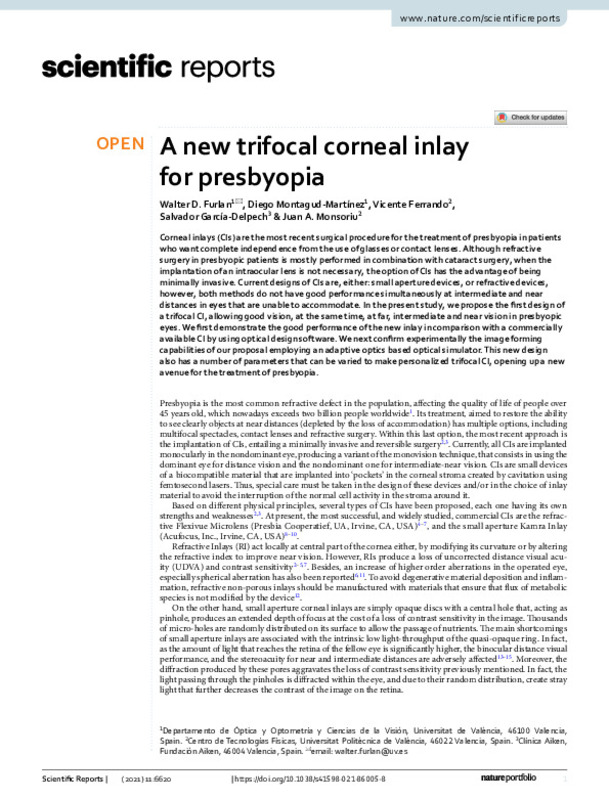Fricke, T. R. et al. Global prevalence of presbyopia and vision impairment from uncorrected presbyopia: Systematic review, meta-analysis, and modelling. Ophthalmology 125, 1492–1499 (2018).
Charman, W. N. Developments in the correction of presbyopia II: Surgical approaches. Ophthal. Physiol. Opt. 34, 397–426 (2014).
Moarefi, M. A., Bafna, S. & Wiley, W. A review of presbyopia treatment with corneal inlays. Opthamol. Ther. 6, 55–65 (2017).
[+]
Fricke, T. R. et al. Global prevalence of presbyopia and vision impairment from uncorrected presbyopia: Systematic review, meta-analysis, and modelling. Ophthalmology 125, 1492–1499 (2018).
Charman, W. N. Developments in the correction of presbyopia II: Surgical approaches. Ophthal. Physiol. Opt. 34, 397–426 (2014).
Moarefi, M. A., Bafna, S. & Wiley, W. A review of presbyopia treatment with corneal inlays. Opthamol. Ther. 6, 55–65 (2017).
Beer, S. M. C. et al. A 3-year follow-up study of a new corneal inlay: Clinical results and outcomes. Brit. J. Ophthalmol. 104, 723–728 (2020).
Limnopoulou, A. N. et al. Visual outcomes and safety of a refractive corneal inlay for presbyopia using femtosecond laser. J. Refract. Surg. 29, 12–18 (2013).
Garza, E. B., Gomez, S., Chayet, A. & Dishler, J. One-year safety and efficacy results of a hydrogel inlay to improve near vision in patients with emmetropic presbyopia. J. Refract. Surg. 29, 166–172 (2013).
Malandrini, A. et al. Bifocal refractive corneal inlay implantation to improve near vision in emmetropic presbyopic patients. J. Cataract Refract. Surg. 41, 1962–1972 (2015).
Waring, G. O. Correction of presbyopia with a small aperture corneal inlay. J. Refract. Surg. 27, 842–845 (2011).
Vilupuru, S., Lin, L. & Pepose, J. S. Comparison of contrast sensitivity and through focus in small-aperture inlay, accommodating intraocular lens, or multifocal intraocular lens subjects. Am. J. Ophthalmol. 160, 150–162 (2015).
Vukich, J. A. et al. Evaluation of the small-aperture intracorneal inlay: Three-year results from the cohort of the US Food and Drug Administration clinical trial. J. Cataract. Refract. Surg. 44, 541–556 (2018).
Beer, S. M. et al. One-year clinical outcomes of a corneal inlay for presbyopia. Cornea 36, 816–820 (2017).
Pinsky, P. M. Three-dimensional modeling of metabolic species transport in the cornea with a hydrogel intrastromal inlay. Invest. Ophthalmol. Vis. Sci. 55, 3093–3106 (2014).
Gilchrist, J. & Pardhan, S. Binocular contrast detection with unequal monocular illuminance. Ophthal. Phys. Opt. 7, 373–377 (1987).
Plainis, S. et al. Small aperture monovision and the Pulfrich experience: Absence of neural adaptation effects. PLoS One 8, e75987. https://doi.org/10.1371/journal.Pone.0075987 (2013).
Castro, J. J., Ortiz, C., Jiménez, J. R., Ortiz-Peregrina, S. & Casares-López, M. Stereopsis simulating small-aperture corneal inlay and Monovision conditions. J. Refract. Surg. 34, 482–488 (2018).
Furlan, W. D. et al. Diffractive corneal inlay for presbyopia. J. Biophoton. 10, 1110–1114 (2017).
Kipp, L. et al. Sharper images by focusing soft X-rays with photon sieves. Nature 414, 184–188 (2001).
Andersen, G. Large optical photon sieve. Opt. Lett. 30, 2976–2978 (2005).
Menon, R., Gil, D., Barbastathis, G. & Smith, H. I. Photon-sieve lithography. J. Opt. Soc. Am. A 22, 342–345 (2005).
Giménez, F., Monsoriu, J. A., Furlan, W. D. & Pons, A. Fractal photon sieve. Opt. Express 14, 11958–11963 (2006).
Montagud-Martínez, D., Ferrando, V., Machado, F., Monsoriu, J. A. & Furlan, W. D. Imaging performance of a diffractive corneal inlay for presbyopia in a model eye. IEEE Access 7, 163933 (2019).
Montagud-Martínez, D., Ferrando, V., Monsoriu, J. A. & Furlan, W. D. Optical evaluation of new designs of multifocal diffractive corneal inlays. J. Ophthalmol. 2019, 9382467 (2019).
Montagud-Martínez, D., Ferrando, V., Monsoriu, J. A. & Furlan, W. D. Proposal of a new diffractive corneal inlay to improve near vision in a presbyopic eye. Appl. Opt. 59, d54–d58 (2020).
Liou, H. L. & Brennan, N. A. Anatomically accurate, finite model eye for optical modeling. J. Opt. Soc. Am. A 14, 1684–1695 (1997).
Vega, F. et al. Visual acuity of pseudophakic patients predicted from in-vitro measurements of intraocular lenses with different design. Biomed. Opt. Express 9, 4893–4906 (2018).
Han, G. et al. Refractive corneal inlay for presbyopia in emmetropic patients in Asia: 6- month clinical outcomes. BMC Ophthalmol. 19, 66 (2019).
Roger, F. et al. Corneal remodeling after implantation of a shape-changing inlay concurrent with myopic or hyperopic laser in situ keratomileusis. J. Cataract. Refract. Surg. 43, 1443–1449 (2017).
Tabernero, J. & Artal, P. Optical modeling of a corneal inlay in real eyes to increase depth of focus: Optimum centration and residual defocus. J. Cataract Refract. Surg. 38, 270–277 (2012).
Monsoriu, J. A., Saavedra, G. & Furlan, W. D. Fractal zone plates with variable lacunarity. Opt. Express 12, 4227–4234 (2004).
Monsoriu, J. A. et al. Bifocal Fibonacci diffractive lenses. IEEE Photon. J. 5, 3400106–3400106 (2013).
Ferrando, V., Giménez, F., Furlan, W. D. & Monsoriu, J. A. Bifractal focusing and imaging properties of Thue-Morse Zone Plates. Opt. Express 23, 19846–19853 (2015).
Bektas, C. K. & Hasirci, V. Cell loaded 3D bioprinted GelMA hydrogels for corneal stroma engineering. Biomater. Sci. 8, 438–449 (2020).
Kirz, J. Phase zone plates for x rays and the extreme uv. J. Opt. Soc. Am. 64, 301–309 (1974).
Moshirfar, M. et al. Retrospective comparison of visual outcomes after KAMRA corneal inlay implantation with simultaneous PRK or LASIK. J. Refract. Surg. 34, 310–315 (2018).
Manzanera, S., Prieto, P. M., Ayala, D. B., Lindacher, J. M. & Artal, P. Liquid crystal adaptive optics visual simulator: Application to testing and design of ophthalmic optical elements. Opt. Express 15, 16177–16188 (2007).
Hervella, L., Villegas, E. A., Robles, C. & Artal, P. Spherical aberration customization to extend the depth of focus with a clinical adaptive optics visual simulator. J. Refract. Surg. 36, 223–229 (2020).
[-]









